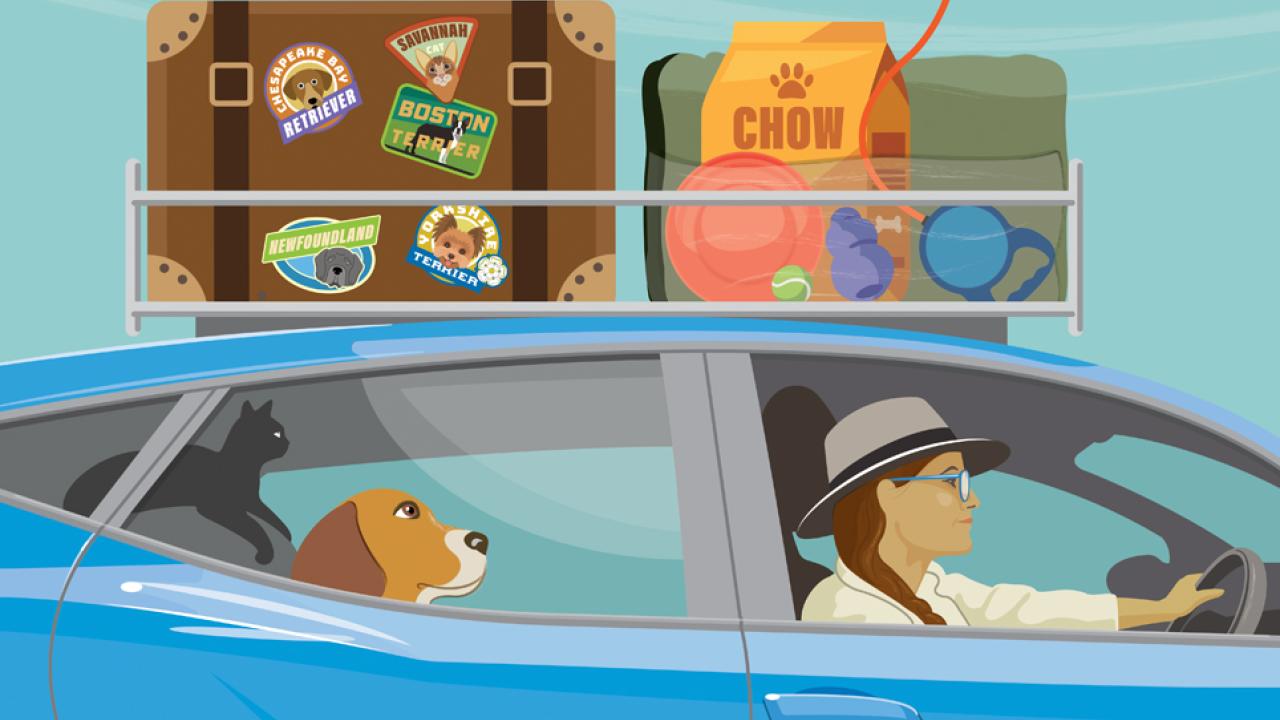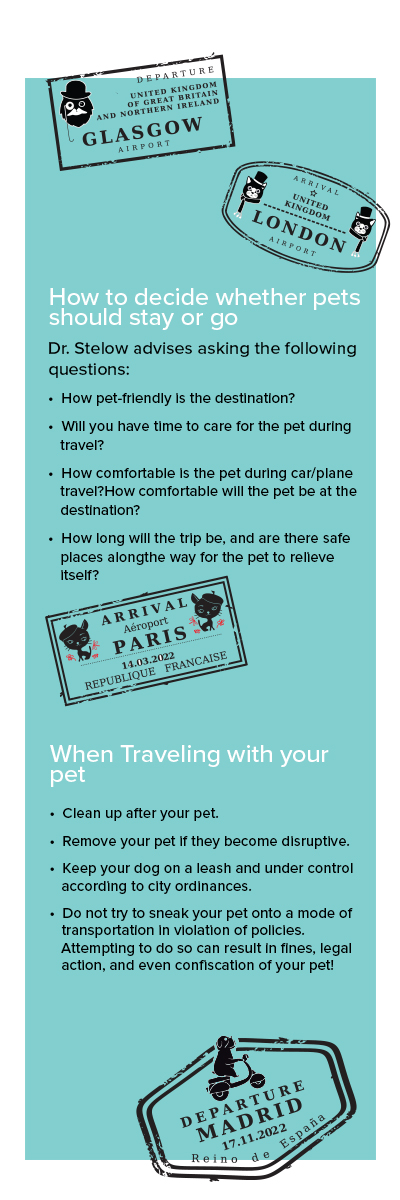
Pet Travel
Should they Stay or Should they Go?

Pet Travel
Pet-friendly services are high priorities for the travel industry, and our companion animals are racking up more miles than ever. Modern travel can be stressful though, so just because Fluffy can go with you does not always mean that she should. Since most companion animals that do travel are dogs and cats, we’ve focused on those species here. Please consult with your veterinarian for considerations of travel with an exotic pet.
We spoke with Dr. Elizabeth Stelow, DVM, DACVB, chief of the UC Davis veterinary hospital’s Behavior Service, about deciding if your pet should stay or go, the realities of pet travel, and tips for arranging care if your furry companion skips the trip. If you decide to take your pet along, be considerate of other guests so that pets will continue to be welcome at your destination(s). Plan ahead, pack extra patience, and keep your sense of humor easily accessible!
PRE-TRIP PLANNING
Planning is often key to low-stress travel, and this is doubly true when traveling with companion animals. Several weeks before you leave, think about:
- Pet identification: Make sure ID tags are up-to-date, that your pet is microchipped, and the microchip is registered with your current contact information. Carry current pictures of your pet.
- Vet visit: Ensure your pet is up-to-date on vaccinations and get a copy of vaccine and health records to carry with you. Talk with your veterinarian about any health or safety risks. Ensure that you have a supply of necessary medications, including preventives like flea medication that may be due while you are away. You may need a Certificate of Veterinary Inspection (CVI), a.k.a. “health certificate,” declaring that your pet is healthy. “Health certificates are needed for plane travel,” said Stelow. “They need to be obtained from a licensed veterinarian during a certain time window of travel. Appointments should be made well in advance.”
- Pack for your pet: Include a harness and leash, and/or carrier of appropriate size that your pet is accustomed to using. Take enough food (especially if your pet is on a special diet), water and medications. Bring a litter box, litter, dishes and other important items, depending on your pet’s needs.
- Last minute details: Confirm plans before you leave. Check guidelines for beaches, trails, and other locations, as many do not allow dogs or policies change seasonally. Put together a list of emergency veterinary options at your destination(s). “It is always a good idea to have a plan for veterinary emergencies,” noted Stelow. “If the pet is traveling by car, look along the route for reputable veterinarians. If by plane, know what services are in the destination location.” Note that rural or wilderness areas may not have easily accessible veterinary services.
Even with meticulous planning, there may be roadblocks. Your pet(s) can sense your stress, so try to be flexible and navigate the twists and turns as calmly as possible.

ROAD TRIP
Road trips are different from rides to the park or the vet. Acclimate your pet to car travel ahead of time. During your trip, make frequent stops (about every two hours) so your pet can have a bathroom break, stretch their legs, and enjoy some mental stimulation.
Pets should not ride loose in a truck bed, on the driver’s lap, or with their head out the window. They also should not travel in the front seat, as deployed air bags can be deadly. Never leave animals in campers or trailers while driving, or in a hot car. Remember that the temperature in parked cars can rise quickly, even on cooler days.

KEEP CALM AND CARRY ON
If your trip includes Fluffy taking to the skies, do your homework. Check age, breed and weight restrictions for your chosen airline. Review pricing and regulations. If you are flying with more than one carrier, check the requirements for each company as they may vary. Note that airlines can limit the number of pets permitted on each flight. Review regulations at your destination.
Consult with your veterinarian about whether your pet should fly on an empty stomach and whether your pet should be sedated. Although sedation might seem like a good way to keep your pet calm, some airlines will not transport tranquilized pets because there is an increased risk of respiratory and cardiovascular problems at higher altitudes. There are also important health considerations for some animals, especially breeds with short muzzles like pug dogs or Persian cats whose breathing may become compromised under sedation. Only administer sedatives under veterinary direction, and never give an animal medication prescribed for humans, as the dosage may be too high and cause dangerous side effects.
Make sure you have the appropriate crate or carrier. Ensure that it has adequate ventilation and is properly labeled. Allow extra time to check-in at the airport.

BY LAND OR SEA
Pet-friendly policies have made their way to some trains, buses, and boats. Note that policies can be limiting, and vary widely. Some may restrict pets to off-peak hours. U.S. Food and Drug Administration regulations prohibit pets from interior spaces where food is prepared, served, or consumed.
Train companies such as Amtrak allow small (20 pounds and under, including weight of pet and carrier) dogs and cats over eight weeks of age on trips less than seven hours, with a limit of five pets per train.
Greyhound bus service does not allow animals on board, with the exception of service animals, but some bus services allow small pets in carriers.
Ferries often allow dogs on outside decks leashed or in a carrier, and may allow small dogs indoors. Pets are generally not allowed on seats, benches, or tables. Some ferries offer complimentary kennels. Most cruise ships do not allow pets.

ACCOMMODATING HOSTS
Whether you stay in hotels, motels, campgrounds, vacation rentals, or crash with obliging friends or relatives, check the pet policies at all of your intended overnight stops. Some properties do not allow unattended pets, so you will need to factor that into your plans for dining and activities. Ask if there will be other animals, including wildlife, on the premises and plan accordingly.
STAYING HOME
Very old, young, pregnant, sick, or injured pets should not travel. Animals that are high-strung, prone to biting, excessive vocalizing, or are not under control with basic obedience commands should also stay at home.
“Not all pets are going to do well during a trip,” said Stelow. “They may be sad to see you go, but that’s no reason to bring them along.”
The good news is that care options for pets that stay home have expanded as quickly as services for pet-friendly travel. Boarding at kennels and veterinary facilities are good choices, especially for pets that have particular medical or exercise needs. Book your pet’s stay early, and review vaccination and other health requirements.
Some pets may be more comfortable staying in their own homes. Pet sitters, who will care for your pet in your home, are available in most areas. Interview potential pet sitters and check references to ensure a good fit. Provide detailed instructions for feeding and exercising, medications, how to reach you, and emergency contacts.
Read our article on choosing a boarding facility for your dog
Whether your pet stays or goes, it is your responsibility to ensure the best decision for the individual animal. Consult your veterinarian if you have questions. To schedule a consultation with the Behavior Service at the UC Davis veterinary hospital, call (530) 752-1393.
*Note that many of the considerations discussed are different for service animals. Check with individual companies and locations for policies.
